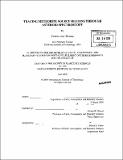Tracing meteorite source regions through asteroid spectroscopy
Author(s)
Thomas, Cristina Ana
DownloadFull printable version (56.89Mb)
Other Contributors
Massachusetts Institute of Technology. Dept. of Earth, Atmospheric, and Planetary Sciences.
Advisor
Richard P. Binzel.
Terms of use
Metadata
Show full item recordAbstract
By virtue of their landing on Earth, meteorites reside in near-Earth object (NEO) orbits prior to their arrival. Thus the population of observable NEOs, in principle, give the best representation of meteorite source bodies. By linking meteorites to NEOs, and linking NOEs to their most likely main-belt source locations, we seek to gain insight into the original solar system formation locations for different meteorite classes. To forge the first link between meteorites and NEOs, we have developed a three dimensional method for quantitative comparisons between laboratory measurements of meteorites and telescopic measurements of near-Earth objects. We utilize meteorite spectra from the Reflectance Experiment Laboratory (RELAB) database and the NEO data from the SpeX instrument on the NASA Infrared Facility (IRTF). Using the Modified Gaussian Model (MGM) as a mathematical tool, we treat asteroid and meteorite spectra identically in the calculation of 1-micron and 2-micron geometric band centers and their band area ratios (BARs). Using these identical numerical parameters we quantitatively compare the spectral properties of S-, Sq-, Q- and V-type NEOs with the spectral properties of the meteorites in the H, L, LL and HED meteorite classes. For each NEO spectrum, we assign a set of probabilities for it being related to each of these meteorite classes. Our NEO-meteorite correlation probabilities are then convolved with NEO source region probabilities to yield a final set of meteorite-source region correlations. An apparent (significant at the 2.1-sigma level) source region signature is found for the H chondrites to be preferentially delivered to the inner solar system through the 3:1 mean motion resonance. A 3:1 resonance H chondrite source region is consistent with the short cosmic ray exposure ages known for H chondrites. The spectroscopy of asteroids is subject to several sources of inherent error. The source region model used a variety of S-type spectra without attempting to infer mineralogy. Yet work by Gaffey et al. (1993) describes the S-asteroid class as home to a wide variety of mineralogies. Using data from the Small Main-belt Asteroid Spectroscopic Survey (SMASS), the 24-color asteroid survey and the 52-color asteroid survey, the spectral parameters of subclass members are investigated to predict possible errors to our model. While spectra are a diagnostic tool, there are factors inherent to the environment of near-Earth asteroids that pose ambiguities, such as grain size, temperature and space weathering.These factors are difficult to deconvolve from the compositional signal and are addressed here by simulated effects on meteorites from RELAB, Moroz et al. (2000) and Strazzulla et al (2005). A long-standing puzzle in asteroid science is the space weathering process and its implications for the relationship between S-type asteroids and ordinary chondrites. While Q-type asteroids are most spectrally similar to ordinary chondrites, these meteorites share certain diagnostic similarities with S-type asteroids. (cont.) Binzel et al. (2004) statistically demonstrated a trend in spectral slope in near-Earth objects from 0.1 to 5 km. This analysis provided a missing link between the Q- and S-type by showing a reddening of spectral slope with larger diameter that corresponds to a transition from Q-type asteroid spectra to S-type asteroid spectra. This reddening of spectral slope is attributed to the effects of space weathering on the observable surface composition. This work shows preliminary results of a photometric survey of small Koronis family members. Observations of these objects were obtained in visible and near-infrared Harris and Sloan filters. Due to their common origin, Koronis family members have shown similar S-type spectroscopic signatures. We assume this consistency applies to the small-unclassified bodies. This provides a unique opportunity to compare the effects of the space weathering process on potentially ordinary chondrite-like bodies within a population of identical initial conditions. By examining a size range similar to the Binzel et al. work we hope to compare the slope reddening transition sizes within the near-Earth population and the main-belt. This data set should prove crucial to our understanding of the space weathering process and its relevant timescales.
Description
Thesis (Ph. D.)--Massachusetts Institute of Technology, Dept. of Earth, Atmospheric, and Planetary Sciences, 2009. Includes bibliographical references (p. 108-120).
Date issued
2009Department
Massachusetts Institute of Technology. Department of Earth, Atmospheric, and Planetary SciencesPublisher
Massachusetts Institute of Technology
Keywords
Earth, Atmospheric, and Planetary Sciences.